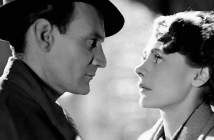
Editor’s Notes: Revolt of the Slaves, The Legend of Custer, Blue Denim, Mr. Moto Takes a Chance, & Dillinger are currently available on their respective home entertainment formats.
Revolt of the Slaves

Revolt of the Slaves (MGM), a 1961 Italian-made sword-and-sandal epic, is a remake of the story Fabiola, filmed twice as a silent picture and once as a big-budget 1949 production. Christians are being persecuted circa 250 A.D. Slave Vibio (Lang Jeffries) refuses to fight in the arena, incurring the wrath of his owner Fabio (Gino Cervi). Fabio’s daughter Claudia (Rhonda Fleming) has him whipped before realizing Vibio is a man of honor and conviction. Claudia’s cousin Agnese (Wandisa Guida) and her boyfriend Sebastian (Ettore Manni) help Vibio to escape. Though Sebastian is the head of the Emperor’s Praetorian Guards, he and Agnese are secretly Christians. When Claudia and Vibio try to help the Christians, their efforts are discovered and the Emperor gives orders to wipe out the Christians.
The interesting slant to this fairly routine plot is that Sebastian turns out to be St. Sebastian, the martyr who inspired innumerable works of art depicting a man bound to a tree and pierced by many arrows. This scene is recreated in the movie.
The movie has an opulent look that reflects a larger-than-average budget. Filmed in color, Italian or Spanish-made epics proliferated for nearly ten years, largely as a result of the popularity of Ben-Hur (1959) and the runaway success of Hercules (1957), starring Steve Reeves. The term given to these historical or Biblical sword-and-sandal movies is “peplum.” While Hollywood was throwing huge sums into such productions as King of Kings, El Cid and Cleopatra, the Italian film industry was churning out its own epics at a fraction of the cost and with tighter shooting schedules. Nineteen movies in the Hercules franchise alone were made between 1957 and 1965. When the popularity of the genre waned, they were replaced by the spaghetti Western.
The MGM Limited Edition contains excellent color and sharp sound. This is the 103-minute English-language version, with carefully rendered dubbing. There are no bonus features on the “Revolt of the Slaves” unrated DVD.
The Legend of Custer

The Legend of Custer (20th Century-Fox Cinema Archives) is set after the Civil War when the Indian wars are being waged. Lt. Col. George Armstrong Custer (Wayne Maunder) has been assigned to command the 7th Cavalry regiment at Fort Hays, an outfit of low reputation. The regiment is composed of ex-Confederates, criminals, and renegades, and has degenerated as discipline has broken down. Custer must whip the soldiers into shape to protect settlers on the surrounding plains by fighting the Kiowa, Sioux and Blackfoot, tribes that are being supplied by a white gunrunner. Custer and his men must rescue General Terry and the Fifth Cavalry regiment from sure death when they are ambushed and trapped by a large Kiowa war party.
Custer has been portrayed countless times in the movies, mostly as an ambitious, glory-seeking officer who led his men into an ambush at the Little Big Horn. The Legend of Custer gives us another view of the man — a sharp military officer who disobeyed orders primarily because he was a better strategist and tactician than his superiors. This feature film is an expanded, re-edited pilot for a TV series that aired a few months in late 1967. It contains plenty of action with lots of stunt work.
As a fictionalized drama, it nonetheless depicts Custer as more than a foolhardy, inept, irresponsible man. Maunder is not the most exciting screen Custer, but serviceable enough. If you’re looking for star power in a Custer flick, check out They Died With Their Boots On, with Errol Flynn. The Legend of Custer DVD is unrated. There are no bonus features. Picture quality looks somewhat washed out, but doesn’t detract much from enjoyment of the movie.
Blue Denim

Blue Denim (20th Century-Fox Cinema Archives), made in 1959, boldly addresses teen sexuality at a time when Hollywood was beginning to treat this age group as real individuals with real problems. Before this, the Hollywood notion of “teen ager” was Andy Hardy, whose biggest difficulty was where he and the neighborhood kids would put on a show. Based on the hit Broadway play, “Blue Denim” is an intelligent, sensitive portrayal of pregnancy and family dysfunction, focusing on Arthur Bartley (Brandon deWilde) and Janet Willard (Carol Lynley), who discover they’re “in trouble” after their first and only sexual encounter.
Though the film doesn’t treat teen pregnancy lightly, it doesn’t resort to melodrama. In fact, the movie realistically deals with a difficult subject, particularly since it was made during the Eisenhower years, when Hollywood was notorious for downplaying controversy in order for its films to reach the widest possible audience. Previous Hollywood films that dealt with out-of-wedlock pregnancy focused on mature and/or disreputable women. Janet is the typical girl next door, so her character generates audience empathy almost immediately. Arthur is depicted not as a wise guy looking for a quick score so he can brag to his buddies, but as a caring, if naive, 16-year-old who feels genuine affection for Janet. Since both deWilde and Lynley are young and attractive, they defy stereotypes of the time.
Janet’s father (Vaughn Taylor) is an upstanding college professor determined to raise his only daughter with a strict code of morality. Arthur’s father (Macdonald Carey) is a retired army officer who repeatedly preaches about the value of life in the service and is preoccupied with his moments of past glory. Warren Berlinger plays Ernie, Arthur’s best friend, who doubles as Arthur’s confidante.
The film’s ending, unfortunately, seems a cop-out in an otherwise forward-thinking picture, but I suppose under the old Production Code, it was necessary in order to get the movie made. For the most part, however, Blue Denim is still a powerful motion picture. The unrated, widescreen DVD release contains no bonus features.
Mr. Moto Takes a Chance

Mr. Moto Takes a Chance (20th Century-Fox Cinema Archives), made in 1938, stars Peter Lorre as Japanese detective Mr. Moto working undercover as an archaeologist studying Cambodian ruins. His real mission: locating munitions dealers who are stockpiling weapons in Southeast Asia. Other characters are aviatrix Victoria Mason (Rochelle Hudson), newsreel photographer Marty Weston (Robert Kent), and Weston’s assistant, Chick Davis (Chick Chandler). The news team runs afoul of high priest Bokor (George Regas), who displays little trust for white people, and area monarch Raja Ali (J. Edward Bromberg), who has trouble separating the good guys from the bad.
Lorre gets to put on various disguises, exercise a bit of martial arts and comes off as more colorful than many B-flick characters of the era, though Charlie Chan still takes the prize as best Hollywood B-movie detective. Lorre conveys both intelligence and humor as he investigates what might be a sinister plot that can affect the entire world.
Picture quality on the DVD release varies. Stock footage and footage shot at the studio don’t match, and sharpness isn’t consistent. Interiors look best, with atmospheric lighting enhancing the black-and-white photography.
Mr. Moto, created by American author John P. Marquand, appeared in six novels between 1935 and 1957. Lorre portrayed the detective in eight motion pictures between 1937 and 1939. (This was a period when Caucasian actors routinely portrayed Asians.) In the earlier Moto films, espionage played a significant role in the plot. The later films were mysteries in the mold of Fox’s Charlie Chan series.
Dillinger

Dillinger (Arrow Video), directed by John Milius, stars Warren Oates as 1930s gangster/bank robber and Public Enemy No.1 John Dillinger. Set in a 13-month period from 1933 to 1934, the 1973 film concentrates on the rise of Dillinger’s notoriety and the dogged determination of a lawman to stop the gangster’s crime spree.
Melvin Purvis (Ben Johnson) is the FBI Midwest bureau chief who gunned Dillinger down outside Chicago’s Biograph Theatre. Cloris Leachman plays the mysterious Lady in Red, Anna Sage, who tipped off the Feds that he’d be at the theater. Michelle Phillips, making her film debut after having been a member of The Mamas & The Papas singing group, plays Dillinger’s girlfriend. Also appearing are Richard Dreyfuss (Baby Face Nelson), Geoffrey Lewis (Harry Pierpont), and Harry Dean Stanton (Homer Van Meter).
Playing fairly loose with the facts, the movie is nonetheless entertaining, drawing upon many gangster movie cliches. Oates does an effective job romanticizing Dillinger, but it’s more a surface representation than an in-depth look at the workings of the criminal mind.
If dark comedy is to your taste, you’ll find it here. The movie owes a lot to Arthur Penn’s Bonnie and Clyde — made six years earlier — with its Depression Era milieu, vintage cars, and violent action staged excitingly by Milius.
Bonus features on the R-rated Blu-ray release include audio commentary by Stephen Prince, author of “Savage Cinema” and “Screening Violence;” newly filmed interviews with producer Lawrence Gordon, Director of Photography Jules Brenner, and composer Barry De Vorzon; stills gallery; reversible sleeve featuring original and newly commissioned artwork; and collector’s booklet about fictional portrayals of John Dillinger plus an on-set report containing interviews with writer/director John Milius and others.



